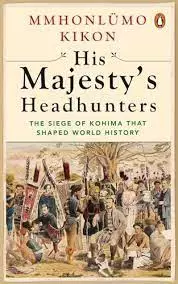Book Review | Untold tales of Naga valour in our Stalingrad of the East
The narrative explores the treacherous terrain, power struggles, and the strategic contributions of the Nagas

His Majesty’s Headhunters: The Siege of Kohima that Shaped World History. (Image: DC)
The northeast of India is terra incognita for many Indians, including me. Our vision of the country stops somewhere in Bengal, and a little beyond that, in Assam. Manipur comes into view because of the trouble that erupts there from time to time. We have heard of Cachar but vaguely. And we do not the importance of Burma in this part of the country. It is against this background of the blurred vision of the reader that author Mmhonlumo Kikon comes up with an enchanting narrative of the war heroes, the Nagas, the British, the Japanese, and going back a hundred years and more, the Nagas, the Manipuris, the Ahoms, the Burmese and the East India Company employees, fighting in the most treacherous terrain of forests, hills and valleys, and compared this eastern battleground with that of the three battles of Panipat in a way that makes them look like such simple affairs. It is not an easy task, but Kikon pulls it off with much aplomb by turning it into a fire-side story-telling. It keeps you glued because it is told in crisp profiles of generals and soldiers, and the power struggles between the different forces. It is the literary flair of Kikon — he is a student of English literature and a former Nagaland legislator — that makes the reading of this book a pleasure.
The detailing done in an easy and compelling narrative is the key to the story that Kikon tells in this books. The Nagas played a strategic role of carrying supplies and of carrying wounded British soldiers in uncharted jungle paths that made for the British victory at the Battle of Kohima in June 1944. Kikon writes: “The baskets woven by the coarse nimble hands of the Naga headhunters carried the ammunition, the rations and the medical supplies in the three months of the blitzkrieg. The hands that tilled the terraced fields and the jhum fields became the porters for the British army.” The Japanese army too fell back on the Nagas to help with supplies, but they were compelled to force Nagas while the British side was generous. It tilted the balance of the battle in favour of the British.
It is the daring act of Lance Naik Yambamo Lotha performed on the night of April 13, 1944, that turned the outcome, and Kikon describes it: how, letting out the war cry of the headhunter, a natural inheritance from his forefathers, Yambamo commenced it, and how it shook the Japanese soldiers engaged in revelry, and they ran helter-skelter, and Yambomo jumped into the camp with his traditional weapon, the dao, and attacked the fleeing enemy soldiers, setting off their heads in full battle fury. Kikon sums it up with admirable brevity: “The Japanese, for all their initial successes in Kohima, would see a change in their fate after this attack by one Naga matching the mighty Japanese Samurai.”
The climactic act of Yambamo suddenly lights up the battles that the jungles of the Northeast witnessed in the contest between the Burmese invasions of early 19th century, the Anglo-Burmese wars, the powers tussles between the Burmese on the one side, and the rulers of Manipur, Cachar and Ahoms, on the other, with the help of the British, and the Battle of Kohima, the daring of Yambamo, all fall in place. Geography shapes culture, people and politics.
Kikon keeps it brief telling the stories of the rise of Manipur as a military power in the region in the 18th century under Penheiba or Raja Garib Nawaz, and its military exploits under Gambhir Singh in the early part of the 19th century. And all the local powers, Manipur, Cachar, Ahoms, the Burmese, the British, and later the Japanese had to contend with the Nagas, divided as they were in different cans and tribes. The Battle of Kohima finds a historical context in Kikon’s telling of the Naga story. It is a complex story and there could be volumes of dry facts written about the changes of political fortune. Kikon cuts through the thick detail and picks up the main features of the situation and the people to move his narrative forward. He explains how the British air transport kept supplies flowing even as the Japanese, who were moving their supply lines through elephants and mules, lost out. Kikon has wisely left out the details of the Battle of Kohima because it has been exhaustively covered in the narratives of the British generals, and focused on the role played by the Nagas.
His Majesty’s Headhunters: The Siege of Kohima that Shaped World History
Mmhonlumo Kikon
Penguin
pp. 256; Rs 599
( Source : Deccan Chronicle )
Next Story

